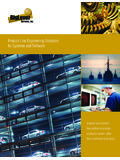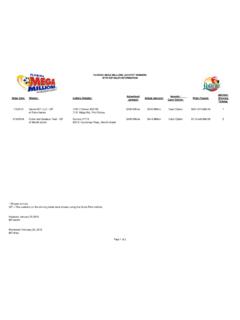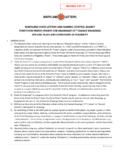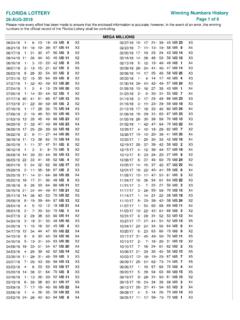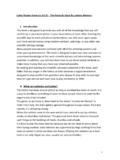Transcription of Mega-Scale Product Line Engineering at General Motors
1 Mega-Scale Product line Engineering at General Motors Rick Flores General Motors 30003 Van Dyke Ave Warren MI 48093 +1 248 207-3494 Charles Krueger BigLever Software 10500 Laurel Hill Cove Austin, Texas 78730 USA +1 512 426 2227 Paul Clements BigLever Software 10500 Laurel Hill Cove Austin, Texas 78730 USA +1 512 994 9433 ABSTRACT General Motors faces probably the most complex Systems and Software Product line Engineering (PLE) challenges ever, in terms of Product complexity, richness of variation, size of organization, and an unforgiving requirement to support over a dozen simultaneous development streams all geared towards each new model year. To meet this challenge, GM turned to an advanced set of explicitly defined Product line Engineering solutions, which have been referred to as Second Generation PLE (2 GPLE). This includes reliance on features as the lingua franca to express Product differences in all phases of the lifecycle, deeply nested hierarchical Product lines, industrial strength automation to provide modeling consistency throughout, and more.
2 This paper explains how 2 GPLE is being applied at General Motors , and the technical and organizational lessons learned so far. Categories and Subject Descriptors [Design tools and techniques]: Product line Engineering , software Product lines, feature modeling, hierarchical Product lines General Terms Management, Design, Economics. Keywords Product line Engineering , software Product lines, feature modeling, feature profiles, bill-of-features, hierarchical Product lines, variation points, Product baselines, Product portfolio, Product configurator 1. INTRODUCTION This is the story of a Product line Engineering effort under way at General Motors . The Product line involves the electronic control systems placed aboard vehicles during manufacturing. These control systems includes electrical components (sensors and actuators), electronic control units laid out in a given topology around the car, wires and data networks to connect the components appropriately, and the software that runs it all loaded correctly onto each vehicle.
3 Like all Product line stories, this one focuses on a particular set of aspects that set this one apart from others. While the effort is very much a work in progress, the piloting and roll-out effort is far enough along to allow us to confidently describe these aspects of the solution: 1. How solving this Product line Engineering problem requires every dimension of what has come to be called the second generation approach to Product line Engineering . The dimensions that play the largest role in the GM story include (1) consistent and traceable treatment variation points, chosen from a very small set of variation mechanisms, in artifacts from every phase of the Engineering lifecycle, from requirements through design and implementation, to deployment on hardware, to calibrations; (2) the role of features as the way in which variation is expressed throughout the Product line ; and (3) the introduction of deeply nested hierarchical Product lines and the ways in which the Product lines that populate the hierarchy interface with each other and respect the information boundaries that correspond to long-established organizational structures.
4 2. How a very small but consistent set of Product line constructs are proving to be adequate to provide the necessary expressive power for this Product line . 3. How the automation that is required to power the Product line solution depends not only the its own technical capabilities but also on vendor business partnerships that allow it to work seamlessly with a variety of life cycle Engineering tools that store artifacts in proprietary formats artifacts that need to have variation points injected into them. These aspects are made compelling because of the unprecedented complexity involved in this Product line . If these solutions work here, it is unlikely they will be found inadequate anywhere else. 2. A Mega-Scale Product line General Motors is the largest automotive manufacturer in the world [1]. In 2011 it sold over 9 million vehicles, produced (with its partners) in 31 countries around the world.
5 That works out to over 1,000 vehicles rolling off assembly lines every hour. The Product line we describe is built under the Next Generation Tools (NGT) initiative at General Motors . GM introduced NGT to tackle the complexity brought on by (among other things) the introduction of hybrid and alternative-fuel vehicles and new active safety features that require intricate and unprecedented orchestration among vehicle subsystems. Product line Engineering is a key ingredient of NGT. Permission to make digital or hard copies of all or part of this work for personal or classroom use is granted without fee provided that copies are not made or distributed for profit or commercial advantage and that copies bear this notice and the full citation on the first page. To copy otherwise, or republish, to post on servers or to redistribute to lists, requires prior specific permission and/or a fee.
6 SPLC '12, September 02 - 07 2012, Salvador, Brazil Copyright 2012 ACM 978-1-4503-1094-9/12 $ 2012 Software Product line Conference Best Paper Award in Industrial Track General Motors may well represent the most challenging domain in all of Product line Engineering . We characterize it as Mega-Scale PLE due to the fact that engineers must deal with multiple Product line characteristics that measure in the millions although, as we will see, even this term s implied order of magnitude fails by a wide margin to do justice to the problem space: 1. The vehicles are complex. As a group, GM vehicles comprise some 300 engineered subsystems such as brakes, exterior lighting, interior lighting, entry controls, and many more. The Chevrolet Volt runs approximately 10 million lines of code, which is several million more than either the Boeing 787 or the F-35 Joint Strike Fighter [12].
7 Figure 1 Chevy Volt: Ten million lines of code, ready to roll ( GM Company) 2. The variation among vehicles is enormous. GM builds over 60 models under seven brands and divisions. The vehicles may be internal combustion, electric, or both. Customer-visible options include everything from power windows to lane keep assist (a system to help the car stay in the correct highway lane). These options, and many dozens more, fundamentally affect the electronics and software aboard the vehicle. Legislation, not to mention cultural preferences, in the 150+ countries where GM does business also imposes feature constraints. To choose one of many dozens of examples, there are complex interactions between the vehicle s exterior lights (low beam headlights, high beam headlights, tail lamps, brake lights, parking lights, daytime running lights, front fog lamps, rear fog lamps, cornering lamps, reversing lamps, and hazard flashers) in terms of which lights are allowed, disallowed, or required to come on with which others.
8 The lead me to my car feature makes lights come on or flash when the driver presses a button on the key fob. Which lights come on, whether they flash or not, and how long they stay on all are specific to the region and (of course) what exterior lights are actually on the vehicle. The electronics aboard every car has to get that behavior right for that car. A simple thought experiment helps to grasp the astronomical magnitude of the variation involved. We can think of vehicle rolling off an assembly line as the result of making a very large set of yes-or-no decisions. The set of all possible vehicles results from all possible combinations of those yes-or-no choices. The size of that Product space is 2x, where x is the number of decisions. If x>260, then the Product space comprises more combinations than the number of atoms in the observable universe [19].
9 For GM, x is in the low thousands. (The number of variants that GM actually produces is much less than that, obviously a number in the low tens of thousands.) 3. Feature interaction abounds. The lighting example above illustrates interactions within a subsystem (exterior lighting) but other features require complex interactions among completely different subsystems. For example, the presence of park assist (a feature to help park the car) requires the presence of a sensor to gauge the car s position relative to the parking space. On some cars this will be a sonar detector, while on others it will be a camera. Park assist also requires brakes that accept software control, and some versions of park assist require particular versions of steering controls. Thus, the presence of a customer-visible feature can affect multiple subsystems, requiring communication and coordination among the subsystems on the car, and among the groups that are responsible for the subsystems involved.
10 4. The Product line must be in lockstep with current and future model years. GM has to plan their production years in advance. Features that won t be in the showroom for 3-5 years are already part of today s Engineering . And the entire Product line marches in unwavering lockstep with the calendar, fixed and unforgiving, which defines each new model year. This means that the Product line infrastructure must support concurrent Engineering streams for each of the fixed yearly cadences, as well as concurrent development cadences for release cycles scheduled every 6 weeks throughout the year. There may be as many as 15 active, concurrent Engineering baselines that engineers must contribute to and coordinate among. The temporal dimension of the problem exhibits astronomical complexity as well.
